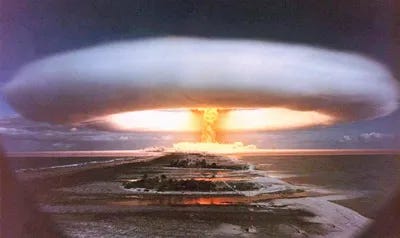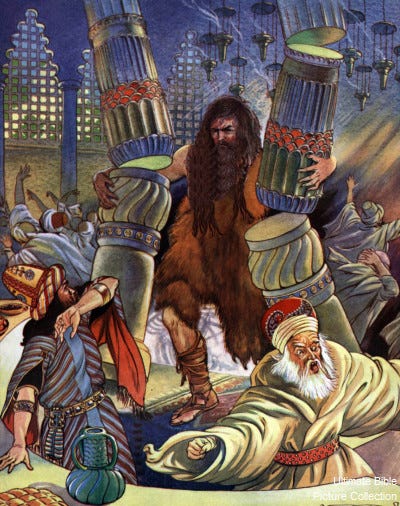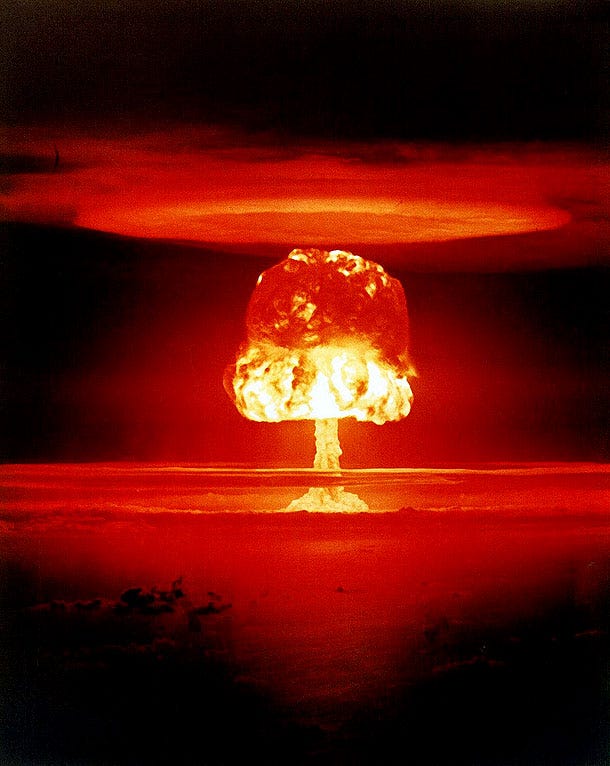Today we are taking a break from our regularly scheduled programming to discuss the conflict in the Middle East. Many Americans, and many others around the world, are upset that the United States continues to fund and arm Israel as the Israelis engage in what many consider to be a genocide. Without condemning, or condoning Israel’s actions, it’s important to understand the United States position, from the Realpolitik angle.
If America stops militarily supporting Israel, it could easily trigger World War 3. At the same time, our continued support for Israel could also easily trigger World War 3.
There’s a critical aspect of the Middle East conflict, the most dangerous of all, that remains largely unspoken, both in mainstream media and across most so-called independent outlets: Israel’s Samson Option.
Named after the biblical figure who brought down the temple on himself and his enemies, the Samson Option is Israel’s last-resort nuclear doctrine: the use of nuclear weapons in the event of an existential threat to the state.
Israel maintains a policy of nuclear ambiguity, but by most credible estimates, it possesses between 90 and 400 nuclear warheads. That arsenal is not just capable of regional retaliation, it could potentially trigger global catastrophe via nuclear winter.
The term was popularized by Pulitzer Prize–winning journalist Seymour Hersh in his 1991 book The Samson Option, which presented interviews with Israeli officials who made no secret of their resolve. Hersh quotes one source with first-hand knowledge of the program:
“We can still remember the smell of Auschwitz and Treblinka. Next time we’ll take all of you with us.”
This chilling logic is not mere historical artifact. In 2003, military historian Martin van Creveld offered a stark summary of Israel’s doctrine in The Gun and the Olive Branch:
“We possess several hundred atomic warheads and rockets and can launch them at targets in all directions, perhaps even at Rome. Most European capitals are targets for our air force… We have the capability to take the world down with us. And I can assure you that that will happen before Israel goes under.”
This posture isn’t just a military strategy, it’s deeply woven into the collective memory of historical trauma. In 2012, Nobel laureate Günter Grass published a poem criticizing Israel’s nuclear policy, prompting a response from Israeli poet and Holocaust survivor Itamar Yaoz-Kest, who wrote:
“If you force us yet again to descend from the face of the Earth to the depths of the Earth—let the Earth roll toward the Nothingness.”
The implications are global. In his 2012 book How the End Begins, journalist Ron Rosenbaum wrote:
“Israel could bring down the pillars of the world—attack Moscow and European capitals.”
This is not just literary flourish. These doctrines are taken seriously at the highest levels of military strategy. In 2002, political scientist David Perlmutter wrote in the Los Angeles Times:
“What would serve the Jew-hating world better in repayment for thousands of years of massacres but a Nuclear Winter?... For the first time in history, a people facing extermination… have the power to destroy the world. The ultimate justice?”
These aren’t fringe voices. They are statesmen, poets, professors, and defense officials. The Samson Option is not a bluff. It is a strategy built on the premise that if Israel’s survival is threatened, no one should expect to survive unscathed.
We ignore this dimension of the conflict at our peril. This is not simply about Palestine or Gaza, nor just about Zionism or anti-Zionism. It is about nuclear brinkmanship rooted in historical trauma and geopolitical isolation.
If Israel perceives an existential threat, they have made it clear that they are willing to nuke the entire planet.
It is time for sober public discourse about this. Silence does not reduce risk, it amplifies it.







